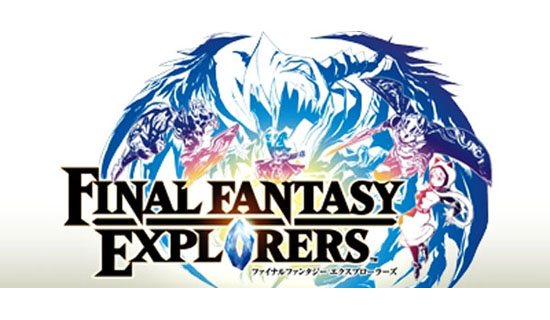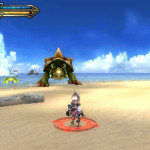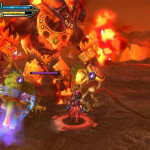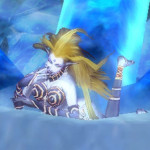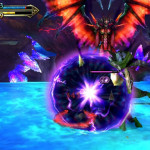In 2010 Square Enix released its first “Monster Hunter clone”, Lord of Arcana. This was a very popular time for Monster Hunter clones, and theirs was considered by most to be the worst in quality, and was certainly the worst selling of the bunch. In other words, it was a failure. It wouldn’t be until mid 2014 that Square Enix would appear to try their hand at copying Monster Hunter again with Final Fantasy Explorers. It was a natural thing to assume that’s what they were doing, since it was announced as an online 4-player game for the 3DS. What else are games that fit that description other than Monster Hunter clones? Well as it turns out, that isn’t really what Final Fantasy Explorers was at all.
Some people call Monster Hunter an action RPG, but I’ve never really seen it that way, particularly when it comes to combat. The combat in Final Fantasy Explorers feels much closer to an action RPG, and in more ways that of an MMO RPG (this won’t be the last time you hear MMOs mentioned). You have eight slots to fill with abilities for your character, a large amount of which which can be purchased by using skill points, but they generally tend to lend themselves to a specific job class. Speaking of job classes, enter the core of this entire game: The Final Fantasy job system. That’s right, the good old Final Fantasy job system that everyone loves! Whether you know it from Final Fantasy 3, 5, 11 or 14, it will feel quite familiar here in Explorers. In fact it was the emphasis on the job system that drew me to this game initially, as I think it’s one of the best job systems that any RPG has to offer. It feels incredibly good to build up carefully selected jobs over time, and eventually combine skills from different ones together to turn yourself into the ultimate killing machine (or healing machine, etc). It was also touted from the very beginning that you would be facing off against many of the classic Final Fantasy series summons (Ifrit, Shiva, Bahamut, etc), and you would have the ability to use these summons once defeated, referring to that as entering the Trance state (a nice FF9 reference).
Your hub is a small town in which there is a quest counter and various NPCs to interact with, including shops in which you can upgrade and purchase various items, weapons and armor. Quests are grouped according to difficulty by star rankings, and when undertaking quests you are traveling through a large map that is divided into smaller zones. Each area contains many different minor enemies, which drop some sort of part or item when dispatched. So how is it that this isn’t just another Monster Hunter clone, given that it certainly sounds like one? As was previously eluded to, it’s all in the combat system. Once you actually get out in that field and start using your abilities, those who have played Final Fantasy 11 or 14 will start to feel much more at home than anyone who has played Monster Hunter. Each ability has a cool-down period that it goes through before you can use it again, and there is a general meter that depletes slightly with each skill that you use, but also auto replenishes as time passes. When the game really starts to feel like a light MMO though, is when you fight your first summon, Ifrit. Some of his attacks are AOE (Area of Effect) attacks that are projected slightly ahead of when he does them with a red circle showing the area in which his attacks will land. It doesn’t get much more MMO-like than that.
What little story the game has to offer revolves around the idea of being an Explorer, seeking out crystals in various locations around the world which are guarded by the aforementioned Final Fantasy series summons. The world of Final Fantasy Explorers unfolds before you little by little, with access to new areas increasing every few quests. One of the game’s major design flaws however, is that it relies a little too heavily on traversal of the world (or exploring, if you will) as a key component. The world map does eventually get fairly large, and you are always made to walk through quite a few areas before you can finally reach the area where your quest objective can be achieved. Was this actually deemed a necessary or even fun thing to do? A better compromise would have been to start the player off in an area that was at least reasonably close to their destination, in order to save a significant amount of on-foot travel time. It may sound minor, but when you’ve done multiple quests in a row it starts to feel very taxing to do each time. And what makes this feel even worse is that the design of the world itself is not particularly interesting. You always seem to be thrown into some variation of a field or cave, so don’t expect to want to stop and take in the scenery.
It’s not that Final Fantasy Explorers shouldn’t exist, or doesn’t have a place. The idea of a light, mission-based MMO style game continues to be an intriguing one. But it seems that this game wasn’t given much consideration past setting up the game systems, creating an overwhelming sense of monotony at times. Even if I do tend to prefer the more action oriented, reaction based style of combat found in games like Monster Hunter to the more methodical style found in MMOs, Final Fantasy Explorers will certainly get another chance from me after it’s had the opportunity to go through some refinement. A sequel released after a review of how the game could be made to flow better could be just what Final Fantasy Explorers needs to turn it into a good franchise. Until such a time comes (if it does come), this game is certainly packed full of enough content to keep appreciators busy for quite some time (10 star levels worth of quests). There also has been a steady stream of both paid and free DLC, in the form of armor sets and quests, as of at least the first month following release.
